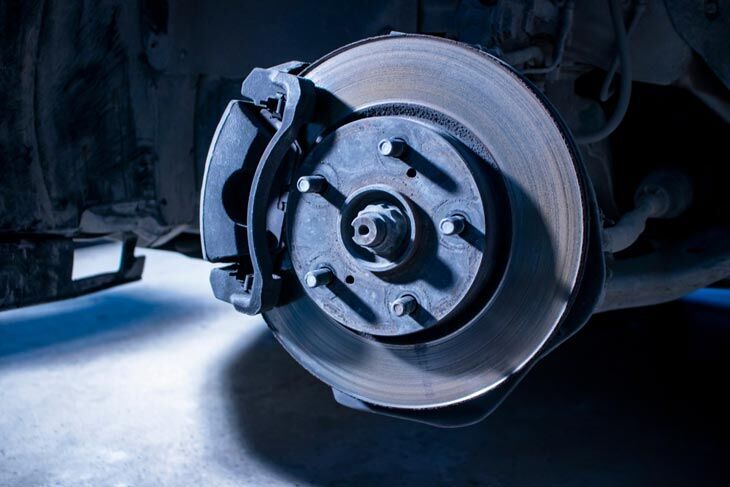
Why does my car sound like a helicopter ?
Twisted brake caliper, torn brake rotor, inoperative parking brake, bad brakes, defective wheel bearing, broken fan clutch motors/poor-quality tires, exhaust leak, vacuum leak, faulty catalytic converter, problems with engines, exhaust systems, flywheel, and water pump are just a few to name.
There are a lot of other possibilities when it comes to car making helicopter noise. Our next section will explore in detail why car engines sound like helicopters .
1. Twisted Brake Caliper
Once the brake caliper has been deformed, its rotor would have no choice but to grate incessantly against the discs inner surface.
These constant grindings result in crunching helicopter-like sound - and might even cause the wheels to seize up during brake usage.
These symptoms are pretty obvious to most drivers, as the brakes efficacy often experiences a dramatic and noticeable drop.
2. Torn Brake Rotor
Similarly, tears and cracks push the brake rotors to scrape against the discs interior compartments. These instances stem from the huge space between it and the caliper as the pad breaks out.
As a result, the brake pads come in close contact with the rotors external rears, causing your vehicle to vibrate upon brake operation. In more severe cases, it might even come to a halt.
3. Inoperative Parking Brake
Worse, sometimes the brakes even engage and disengage by themselves, which calls for professional examination from experts.
4. Bad Brakes
Poor brake conditions are signified by noticeable creases on the surface, filled with crude and rust.
Those defects keep the brakes from effective rotor grips, giving the impression that all the sounds are emanating from its engine compartments. No wonder your car sounds like a helicopter !
5. Defective Wheel Bearing
Failed wheel bearings produce a yelling sound easily heard from within, which explains why your car engine sounds like helicopter when accelerating .
One tire edge enjoys more resistance while the other continues to spin freely. Pay close attention to them on your next drive and identify which part of your vehicle produces helicopter noises.
6. Broken Fan Clutch Motors and Poor-Quality Tires
Defective fan blades will produce sounds like helicopters whenever you turn your car on or off, making the car accelerate or decelerate on its whim.
In the same vein, bad tires generate loud humming noises at faster speeds and only fade away once you slow down.
Such occurrences indicate a lack of proper gripping force, which might put you in danger if not fixed right away.
7. Exhaust Leak
All these clogging exhaust pipes generate more helicopter noise from front of car .
8. Vacuum Leak
Clicking sounds also originate from vacuum leaks, though these sounds tend to occur upon acceleration only. Other activities (such as cornering or slowing down) will not suffer from any impacts.
Still, we suggest you not leave this issue untreated for too long. Otherwise, the gasoline shortage from your engine might eventually render the car inoperable.
9. Faulty Catalytic Converter
One feasible factor behind helicopter noises is the failure to convert carbon monoxide into carbon dioxide (CO-CO2), implying a damaged catalytic converter .
How can you identify this issue? The answer is pretty simple: you may see water or oil pooling beneath the car after parking.
10. Engine Problems
Below are three methods to fix the bothersome helicopter sounds for your automobiles.
- Method 1: Renew transmission fluids
- Method 2: Change to new wheel bearings
- Method 3: Replace the CV axle
We will break each one into detailed, smaller steps. Do not skip any!
1. Renew Transmission Fluids
Step 1. Unbolt the pan and jack up your car. As the ATF drains out, remember to put a tarp and a pan beneath it.
Step 2. Remove and replace the filter.
Passaggio 3 . Get rid of the old gearbox pan gasket to install a new one. Then bolt the pan and fill it with ATF.
Step 4. Start the automobile and keep an eye on potential leaks.
Step 5. Clean up the mess with kitten litter.
2. Change to New Wheel Bearings
Step 1. Park on a level surface to avoid the worst possible outcomes (such as the car rolling away).
Step 2. There are some bearings you are not going to replace. Pick some wheel chocks to secure them in place, giving the car increased stability.
Step 3. Undo the nuts before using a jack to lift this wheel. This move gives you appropriate access to the structural parts of the faulty bearing.
Step 4. Remove the races, which often call for high-performance tools such as mallet, chisel, and grinder. Of course, you should have substitute races prepared at hand. Remember to clean the load frame from the inside out when you finish.
Step 5. Put in new races and wheel bearings with a few hammer hits. Ensure they are aligned and shoved in as far as possible. Also, check whether the sealant rings lie flat against the assemblys exterior; if they havent yet, fix that immediately.
3. Replace The CV Axle
Several automobile models also include a star wheel, which you should remove, too.
Step 2. Take Off The Axle Nut
Three approaches are possible. The first one is to pick an impact wrench - the simplest tool among the three.
Another method requires you to seize the brakes while unscrewing the bar, which prevents needless axle spinning.
How about the last solution? Keep the wheel running while slowly lifting the automobile off the ground with a floor jack.
Loosen the nut when you finish (remember that you will need to reverse this step in the end, once the whole task is completed).
Step 3. Detach The Ball Joint
Disengage the low control arm to pull the strut and remove axle joints from their bearing hubs. Do not forget to extract the low ball joint, too, to make room for these removals.
Certain ball joints also feature a self-locking cotter. Remove that (if any) using a pair of dikes.
Step 4. Install A Replacement CV Axle
With the replacement axle firmly held, lets reinsert it carefully into the gearbox to avoid destroying the transmission seals. Force it forward to ensure a proper fit.
It might take some time (and a little bit of jiggling) to shove it into the gearbox entirely, so try to be more patient.
This step requires lots of caution; otherwise, improper mounting will dislodge the axle while you are driving, bringing the poor vehicle to a halt.
Step 5. Reinstall the Axle Nut
First, use your bare hands (instead of any instrument) to reinstall the axle nut. This method might be a bit time-consuming, but it will keep cross-threading risks at bay.
Next, screw it back in compliance with the manufacturers torque specifications (usually from 121 to 141 foot-pounds). Finally, tighten the wheel before gradually lowering the vehicle back to the ground.
When driving for the first time, pay attention to any usual sounds. If helicopter noises are still clicking, maybe its time to recheck all the work you have done or bring the car to a repair shop.
Conclusione

Our article has explained why a car sounds like a helicopter when accelerating and delivers several promising solutions.
Most issues can be handled at home pretty well, but you should turn to professional help if your mechanic skills and expertise are below average.
Otherwise, these dilemmas might get worse.
